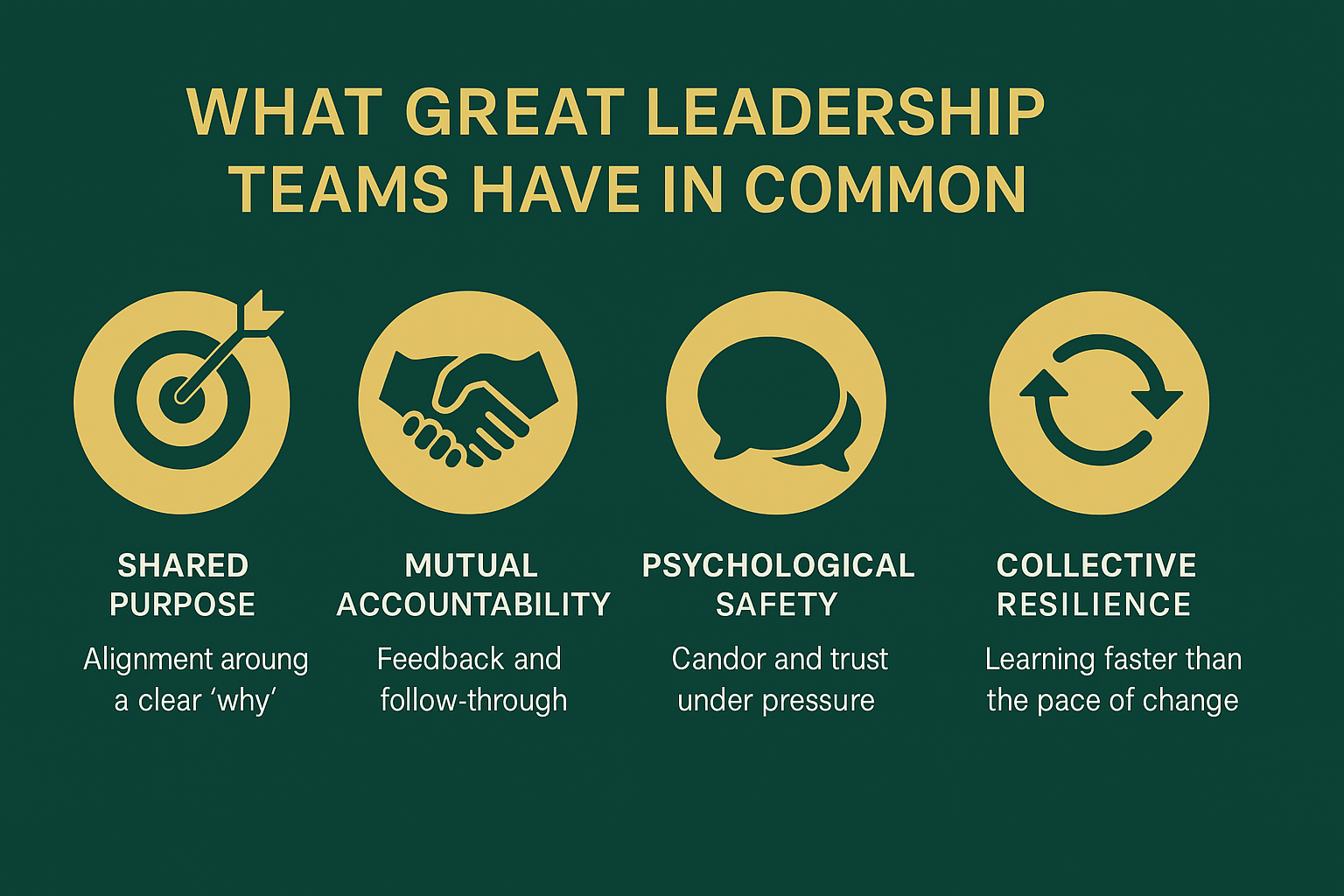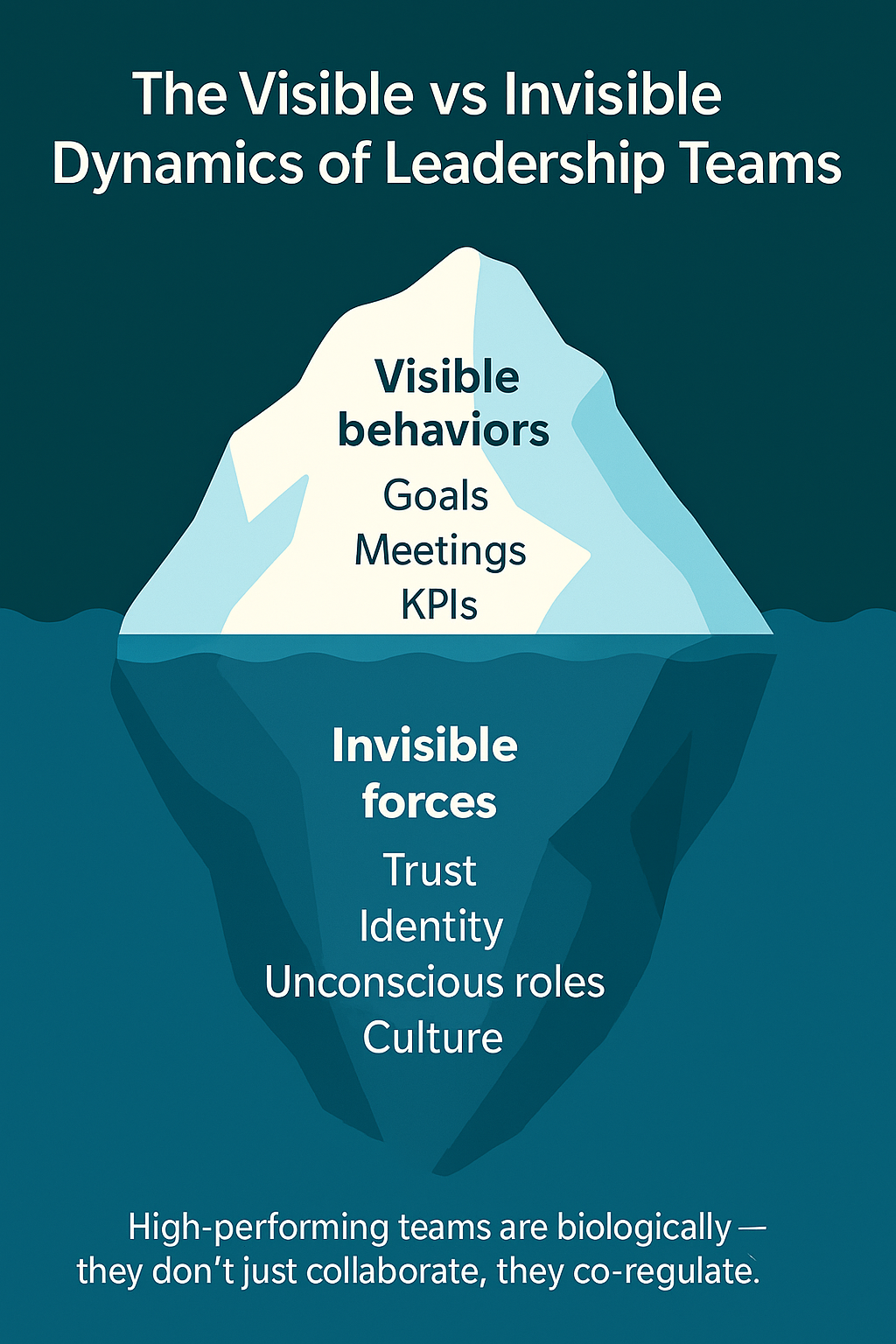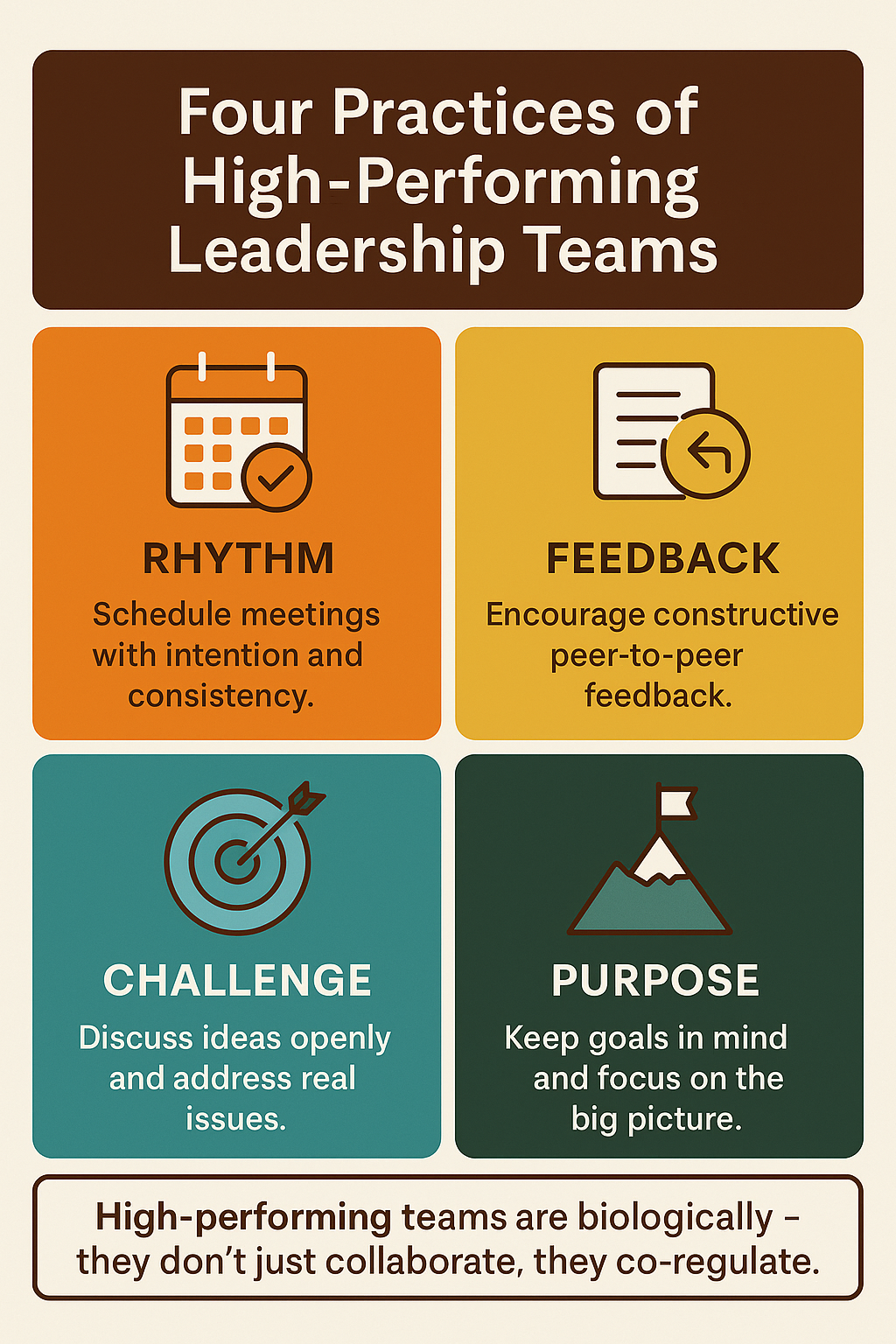High-Performing Leadership Teams: Behind the Scenes of Elite Executive Team Dynamics
Why brilliant leaders often struggle as teams…
Even the most talented executives can underperform together. According to Bain & Company, only 17% of executive teams describe themselves as truly high-performing. The reason isn’t strategy - it’s psychology.
What separates those that thrive from those that merely function isn’t more strategy sessions or away days. It’s the invisible psychological and systemic group dynamics shaping how leaders think, interact and make meaning together.
In this article, we explore what makes elite leadership teams truly work - drawing from behavioural science, systems thinking and decades of leadership coaching across global organisations.
On this page: What defines high-performing teams • Invisible forces • System mindset • Neuroscience of flow • Group Dynamics •Leadership maturity • How to develop one • Red flags & recovery • Psychological safety • Economics • What elite teams do • FAQ
What Defines a High-Performing Leadership Team
The best leadership teams balance clarity with curiosity, performance with reflection, and ambition with empathy.
Shared Purpose: The Anchor of Collective Direction
Every effective team has a unifying story. The best teams don’t just know what they do - they know why it matters. They align around a shared vision that transcends individual targets. This purpose anchors decisions and behaviours when the environment gets turbulent.
Mutual Accountability: From Politeness to Productive Challenge
As Patrick Lencioni describes in The Five Dysfunctions of a Team, high-performing teams move beyond polite agreement. They hold each other accountable, not as criticism but as commitment to shared excellence.
Psychological Safety: The Foundation of Candour and Learning
Amy Edmondson’s research consistently shows that psychological safety - the belief that one can speak up without fear of punishment - predicts performance and learning. In senior teams, where stakes and egos are high, this becomes a defining differentiator.
Collective Resilience: Recovering and Growing Together
Teams that sustain high performance over time are those that can recover from tension and conflict. They use reflection, not avoidance, as a way to learn together.
Figure: What high-performing leadership teams have in common
The Invisible Forces Driving (and Derailing) Executive Team Performance
Every leadership team operates on two levels - the visible (meetings, decisions, strategies) and the invisible (beliefs, assumptions, relationships) (de Vries, 2005, 2011, 2025). It’s in the invisible where most performance gaps live.
Figure: The iceberg of executive team performance
This iceberg graphic aligns well with the psychodynamic systemic group and team coaching approaches of Manfred Kets de Vries, allowing for a deeper understanding of the unconscious dynamics of teams and groups (de Vries, 2005, 2011, 2025).
Trust and psychological safety: The Ground Beneath Every Great Team
Without trust, collaboration becomes performance theatre. Edmondson (1999) found that high-performing teams engage in productive discomfort - they challenge each other’s thinking while maintaining respect.
Group identity and belonging: From Functions to a Collective “We”
Henri Tajfel’s social identity theory (1979) reminds us that teams derive meaning from belonging. A leadership team that sees itself as a collective identity rather than a committee of functions behaves differently - more unified, more agile.
Unconscious group roles and defences: What’s Playing Out Beneath the Surface
Wilfred Bion’s Experiences in Groups (1961) and later Kets de Vries’ work on psychodynamic systemic team coaching (2005, 2025) highlight how unconscious dynamics - such as competition, dependency, or avoidance - can derail progress. Recognising these patterns allows a team to regain agency.
The shadow side of performance: When Strengths Become Risks
Every strength casts a shadow. Drive can become dominance, decisiveness can become rigidity. High-performing teams learn to name their shadows and work with them, not around them.
💬 Coaching Cue: What might your team be avoiding talking about - and what could that avoidance be protecting?
From Group to System: The Psychology of Leadership Team Dynamics
Senior leadership teams aren’t just groups of people - they are systems of influence. Each conversation, behaviour or decision sends a ripple through the organisation.
The Leadership Team as a System of Influence
What happens in the leadership team echoes through the business. If the senior team avoids conflict, so will the layers below. If they show curiosity and alignment, that culture scales too.
Systemic coaching approach: Creating Value Beyond the Room
Systemic team coaching (Hawkins, 2017) helps teams shift focus from internal relationships to their impact on the wider organisation. It reframes success from “how we get along” to “how we create value together”.
Behavioural contagion: How Emotions Spread Across the Organisation
Research in social psychology shows that emotions are contagious. Leaders set the emotional climate. A calm, reflective team generates stability; a reactive one spreads anxiety and confusion.
The Neuroscience of Team Flow
“When leaders sync emotionally and cognitively, performance becomes almost effortless.”
Figure: Neuroscience drivers of team flow
Team flow isn’t poetic - it’s physiological.
When teams enter shared flow states, their prefrontal cortexes synchronise, creating heightened collaboration, creativity, and empathy (Csikszentmihalyi, 1990; Dietrich, 2004). In business, this looks like seamless decision-making and collective intuition.
Pause. Reflect. Lead…
Join a global community of reflective leaders exploring the psychology of transformation and high-performing teams. Join the Newsletter →
Figure: Biological drivers of team flow in leadership teams
Figure: High-performing leadership teams are biologically aligned. They don’t just collaborate; they co-regulate.
The Role of Leadership Maturity in Team Effectiveness
A team can only operate at the developmental level of its members’ collective awareness.
Drawing on Robert Kegan’s theory of adult development, mature leaders move from being shaped by their environment (the “socialised mind”) to shaping it (the “self-authoring mind”). The most advanced leaders reach a “self-transforming” mindset - capable of seeing multiple perspectives simultaneously.
In team contexts, this means:
Seeing conflict as information, not threat
Balancing advocacy with inquiry
Recognising one’s part in collective patterns
Integrating feedback without defensiveness
Bill Torbert’s “Action Logic” model (2004) echoes this: high-performing teams function best when most members operate at Strategist level or beyond - aware of both personal intent and systemic impact.
Reflection for Leaders and Teams
If your leadership team were a mirror of your organisation’s health, what would it reflect today?
The highest-performing teams don’t avoid discomfort - they use it as data. They see conflict as information, difference as fuel, and reflection as a performance advantage.
In a noisy world where pressure and pace dominate, taking time to reflect as a team is both radical and necessary. Coaching creates that space - to think clearly, act decisively and sustain performance through trust, purpose and connection.
When Leadership Teams Click - and When They Don’t
Even at the highest levels, great teams are rare. The difference isn’t raw intelligence or strategy. It’s relational intelligence: how leaders navigate power, emotion, and meaning together.
Research from Harvard Business Review (Wageman, 2008) found that only one in five executive teams operates at full effectiveness. The rest are trapped in cycles of surface-level alignment, hidden tension, or reactive firefighting.
In practice, what separates thriving teams is their ability to balance task, relationship, and reflection. They don’t just meet - they learn. They don’t just decide - they discuss what made the decision possible.
High-performing leadership teams aren’t luck. They’re systems built on awareness, trust and collective accountability.
How to Develop a High-Performing Leadership Team
Creating a high-performing leadership team doesn’t happen by accident. It requires structured reflection and deliberate development.
Figure: Core practices of high-performing leadership teams
1. Establish rhythm and reflection
High-performing teams invest time in reflection, not just reporting. Short retrospectives after key meetings or quarterly check-ins on team effectiveness are simple but powerful routines.
2. Use data and feedback as learning fuel
Tools like Hogan Assessments, 360-degree feedback, or stakeholder interviews provide mirrors that reveal both strengths and blind spots. The key is to use data not as judgement but as learning fuel.
3. Balance challenge with care
Team coaching thrives on “supportive challenge” - creating conditions where team members can question assumptions while feeling psychologically safe. See our blog post on supportive challenge to discover more
4. Revisit purpose and roles regularly
As organisations evolve, so should the leadership team’s mandate. Clear roles prevent overlap and confusion, keeping focus on the system rather than the individual.
Ready to assess your team?
Run a 10-minute leadership team scan to identify strengths, blind spots and first moves. Book a confidential consultation
When Leadership Teams Stall: Red Flags and Recovery Moves
Even strong senior teams stall. Use the red flags below to spot issues early and the “First move” column to recover momentum in your next executive meeting.
| Red Flag | What It Looks Like | Why It Happens | First Move |
|---|---|---|---|
| 🤐Avoidance of conflict |
Meetings feel polite. Real issues surface offline. Decisions slide from one agenda to the next with little productive tension.
If people agree too quickly, you likely missed the real conversation.
|
Low safety; Status risk Speaking up feels costly. Past punishments or politics keep candour low. Leaders overvalue harmony. |
Name the pattern. Set a simple rule for robust challenge. Start with one thorny topic and model curiosity, not certainty. |
| 🧭Decision paralysis |
Endless alignment. Slowed initiatives. Parking lots grow. Teams await permission rather than clear direction.
If everyone owns the decision, no one owns the decision.
|
Unclear RACI Ambiguity Decision rights are fuzzy. Risk aversion and consensus culture dominate. |
Define DRI or RACI for the top 5 decisions. Clarify input vs ownership. Timebox discussion and decide. |
| 🧱Functional silos |
“My team vs your team.” Optimisation inside functions but sub-optimisation across the business. Duplication and friction.
Local wins are costly when the system loses.
|
Competing KPIs Identity over system Reward structures favour parts over the whole. Limited shared metrics. |
Introduce 2 or 3 enterprise KPIs owned collectively. Review trade-offs in a monthly cross-functional forum. |
| 🌀Meeting churn |
Recurring meetings with little learning. Status updates dominate. Actions repeat. Energy drains.
If the calendar runs the team, performance will lag the calendar.
|
Process over purpose No cadence for reflection. Agendas focus on reports rather than decisions and learning. |
Redesign the agenda. 50% decisions, 20% learning, 20% risks, 10% updates in writing. Add a 5-minute retrospective. |
| 🧯Firefighting culture |
Constant urgency. Short-term wins but recurring issues. Strategy time gets pushed out.
Busy and effective are not synonyms.
|
Rewarding heroics No root cause Incentives celebrate rescue, not prevention. Limited capacity for systems thinking. |
Ringfence strategy time weekly. Track repeat incidents. Introduce simple root-cause reviews with owners. |
| 🥊Power plays |
Decisions swing with influence. Data bends to narrative. Stakeholders lobby outside the room.
When influence beats evidence, the system learns the wrong lesson.
|
Status anxiety Low norms Lack of explicit decision rules. Hidden competition for resources and recognition. |
Set decision principles. Require pre-read data. Rotate chairing. Publish decisions with rationale and owner. |
| 🥀Cynicism or burnout |
Shrinking discretionary effort. Eye rolls in meetings. Good people withdraw or leave.
Cynicism is often unprocessed disappointment.
|
Chronic overload Breach of trust Repeated broken promises. No space for recovery. Misaligned workload and priorities. |
Acknowledge reality. Rebalance priorities. Create visible wins and a 90-day energy plan for the team. |
When leaders see these patterns, the temptation is to change processes. Often, what’s needed instead is a deeper look at underlying relationships, beliefs and systemic pressures.
Figure: Red flags when leadership teams stall
Building Psychological Safety at Senior Levels
Most leaders know the phrase psychological safety, but few know how to build it deliberately at senior levels.
At the top, risk and visibility are higher. Saying “I don’t know” or “I was wrong” carries greater weight.
Building psychological safety at this level involves:
Modelling learning behaviour: Senior leaders openly reflecting on what they’re learning signals that inquiry is valued.
Explicit norm-setting: Start each meeting by reaffirming that candour and difference are expected.
Balance of advocacy and inquiry: Encourage questions like, “What might I be missing?”
After-action reviews: Turning Tension into Learning Debriefs focused on learning, not blame.
As Amy Edmondson (2019) writes, safety is not the absence of tension but the presence of candour.
The Economics of Leadership Team Performance
Why should HR or boards invest in leadership team coaching?
Because team underperformance is extraordinarily expensive (and organisationally disruptive).
Figure: Business impact of cohesive executive teams
According to Bain & Company (2022), senior team misalignment can cost 5–10% of annual revenue through duplicated efforts, delayed decisions, and missed opportunities.
When teams increase alignment and reduce relational friction, the business gains measurable ROI in:
Decision speed
Employee engagement
Innovation throughput
Retention of high performers
A 2020 McKinsey study found that companies with cohesive executive teams are 1.9x more likely to deliver above-average profitability.
The financial case for leadership team coaching is not soft - it’s strategic.
What Elite Leadership Teams Do Differently
When I coach senior teams across industries and cultures, the most successful ones share five recurring patterns:
They pause. They make time for reflection and renewal, not just reaction.
They hold boundaries. Meetings start and end with intention; they protect deep work.
They humanise performance. They balance empathy with accountability.
They create clarity. Every team member knows the organisation’s “north star”.
They practise micro-feedback. Real-time correction replaces year-end surprises.
Elite teams don’t avoid discomfort - they work through it faster and wiser learning as they go.
💬 Coaching Cue: How does this show up in your leadership today?
Closing Reflection
If you looked at your leadership team today - not its metrics, but its moments - what would you notice?
Where are the pauses for reflection, the brave questions, the shared learning?
High performance at the top isn’t about more information. It’s about more integration.
As a coach, I’ve seen that once teams learn to slow down, notice their dynamics, and align around shared meaning, their results accelerate naturally. Performance follows awareness.
If your leadership team could benefit from that space - to think clearly, act decisively and perform with trust and connection - I invite you to begin the conversation.
For the bigger picture on how individual leaders, teams and the wider matrix interact in change, see The Psychology of Organisational Transformation in Matrix Organisations.
Ready to see where your leadership team can go next?
If you’re noticing friction, decision drag or polite avoidance, a short systemic diagnostic can reveal exactly where to focus.
👉 Book a confidential consultation to explore how systemic team coaching can help your leadership team move from function to flow.
Lead smarter. Think deeper.
Get monthly insights on leadership psychology, team dynamics and the neuroscience behind high performance - straight from the boardroom to your inbox.
Subscribe to Insights →
Leadership Team Coaching: Your Questions Answered (FAQ)
Q1. What is the most common reason executive teams underperform?
Most often, it’s not strategy or structure - it’s relationship quality. Teams get stuck in cycles of avoidance, competition, or overload. Addressing those human factors is where performance returns multiply.
Q2. How long does leadership team coaching take to show results?
Meaningful shifts usually appear within 3–6 months. Early gains show in meeting quality, clarity of decisions, and engagement energy.
Q3. Is leadership team coaching confidential?
Yes. All discussions within sessions are confidential. Aggregate thematic insights may be shared with sponsors to inform organisational learning.
Q4. What’s the difference between team building and team coaching?
Team building is often a fun off-site to break down barriers and improve social cohesion - there’s no real evidence this particularly helps in high performing team development. Whereas Team Coaching is a more psychologically grounded area requiring expert coaching skills due to the complexity of dynamics. Focusing on how the team works, live issues and how the team creates value together.
Q5. How can we measure success?
Through clear behavioural indicators: improved trust, decision quality, stakeholder feedback, and measurable performance outcomes. Diagnostics like Hogan or team 360s can help track progress.
📚 References
Bain & Company (2023) At the Top, It’s All about Teamwork: What Makes Executive Teams Great. Bain & Company. Available at: https://www.bain.com (Accessed: 22 October 2025).
Csikszentmihalyi, M. (1990) Flow: The Psychology of Optimal Experience. New York: Harper & Row.
Dietrich, A. (2004) ‘Neurocognitive mechanisms of the flow experience’, Consciousness and Cognition, 13(4), pp. 746–761.
Edmondson, A.C. (1999) ‘Psychological safety and learning behavior in work teams’, Administrative Science Quarterly, 44(2), pp. 350–383.
Kegan, R. (1982) The Evolving Self: Problem and Process in Human Development. Cambridge, MA: Harvard University Press.
Kets de Vries, M. F. R. (2005). Leadership group coaching in action: The Zen of creating high performance teams. Academy of Management Executive, 19(5), 61-77.
Kets de Vries, M.F.R. (2011). The Hedgehog Effect. The Secrets of Building High Performance Teams. San Francisco. John Wiley.
Kets de Vries, M. F. R. (2025). The Path to Individual and Organizational Transformation: Confronting the Elephant in the Room. The Palgrave Kets de Vries Library. Cham: Palgrave Macmillan.
McKinsey & Company (2020) High-Performing Teams: A Timeless Leadership Topic. McKinsey & Company. Available at: https://www.mckinsey.com (Accessed: 22 October 2025).
Torbert, W.R., Fisher, D., and Rooke, D. (2004) Action Inquiry: The Secret of Timely and Transforming Leadership. San Francisco: Berrett-Koehler.
Wageman, R., Nunes, D.A., Burruss, J.A. and Hackman, J.R. (2008) Senior Leadership Teams: What It Takes to Make Them Great. Boston, MA: Harvard Business Review Press.
📖 Further Reading
Edmondson, A. (2019) The Fearless Organization: Creating Psychological Safety in the Workplace for Learning, Innovation, and Growth.
A practical look at how leaders create environments where people speak up and learn - essential reading for those building trust within senior teams.
Hawkins, P. (2017) Leadership Team Coaching: Developing Collective Transformational Leadership.
A foundational text for systemic team coaching - bridges psychology, performance and organisational impact.
Eve Coaching & Consulting (2025) Shakespeare’s Seven Stages of Man and Personal Development.
An accessible exploration of developmental psychology through a literary lens, connecting classical wisdom with modern leadership practice.
Read the article →


















